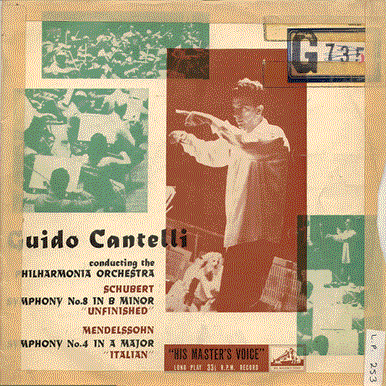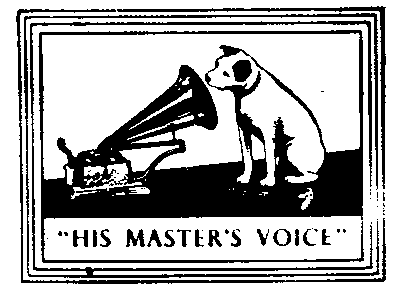

GUIDO CANTELLI - PHILHARMONIA ORCHESTRA

( View LP Cover )
GUIDO
CANTELLI - PHILHARMONIA ORCHESTRA
|
|||
|
|
Band I First Movement—Allegro moderato | ||
|
|
Band 2 Second Movement—Andante con moto | ||
|
|
Band I First Movement—Allegro vivace—Piu animato | ||
|
|
Band 2 Second Movement—Andante con moto | ||
|
|
Band 3 Third Movement—Con moto moderato | ||
|
|
Band 4 Fourth Movement—Saltarello (Presto) | ||
| GUIDO CANTELLI -
PHILHARMONIA ORCHESTRA Schubert SYMPHONY No. 8 IN B MINOR "UNFINISHED" Mendelssohn SYMPHONY No. 4 IN A MAJOR, Op. 90 "ITALIAN" SCHUBERT—SYMPHONY No. 8 "UNFINISHED" MENDELSSOHN—SYMPHONY No. 4 "ITALIAN" SIDE 1 Schubert — Symphony No. 8 "Unfinished" We do not know why Schubert did not complete his B minor Symphony. The two movements that exist were written in 1822. and since he lived for a further six years his early death cannot be said to be the cause. I do not agree with those musicologists who suggest that he never meant to complete it, that he realised that the two movements form a complete whole in themselves. Such an idea would not have occurred to Schubert; in any case he did note down a few sketches for a Scherzo movement but seems never to have begun thinking of a finale)This is so lovable a work in its state of romantic incompletion that one would not want another bar of music added to it. Band 1 — First Movement—Allegro moderato 10.30 The first five bars of the symphony (on lower strings) constitute perhaps the most widely known opening in the symphonic repertoire. They are closely followed by the second part of the first subject, played by oboes and clarinets in unison. This theme is extended and modulated upon, until against a gently syncopated background of clarinets and violas we hear the famous second subject announced by the 'cellos—a smooth, cantabile tune such as only Schubert could write. There is no need for lengthy analysis of the development and recapitulation of the movement. Its direction is always clear, and we are ever willing to follow it. Band 2 — Second Movement—Andante con moto 11.40 This is a rather long movement, remarkable for the charm of its melody and for its graceful character. The main theme is given to all the strings, while the second subject is a typically Schubertian melody heard on the clarinet over a syncopated rhythm in the strings. Throughout the entire movement we are struck by- the warmth and love which are in every sound that Schubert makes. The lack of contrivance, the instinctive feeling for sound which Schubert inherited from Beethoven, the homely Viennese poetry of the melodies—these are the qualities that make the "Unfinished" one of the best loved masterpieces of nineteenth-century Vienna. SIDE 2 Mendelssohn—Symphony No. 4 "Italian" The London Philharmonic Society had. in November 1832, commissioned the young Mendelssohn to compose for the Society a symphony, an overture and a vocal piece. In April, 1833, he delivered the symphony, with two overtures. He had begun work on it during his visit to Italy, and had completed it in Berlin in the winter. The "Italian" Symphony, as it has come to be called, is without doubt the most successful of Mendelssohn's four symphonies (or five, if one includes a very youthful effort) . Its great popularity is due to its gaiety, orchestral colouring, its brilliant organization of sound, and its delightful scoring. Band 1 — First Movement—Allegro vivace—Piu animato 7.57 "Italy at last. What I have been looking forward to all my life as the greatest happiness, is now begun—and I am basking in it. The whole country had such a festive air that I felt as if I were a young prince making his entry." So said Mendelssohn on arriving in Venice. And it is this youthful exultance that finds its way into this movement. One can almost Italian the talian sunshine in the gay, warm and exciting opening bars. This high-spiritedness pervades the entire movement. Band 2 — Second Movement—Andante con moto 5.48 It has been suggested that this movement represents a religious procession such as Mendelssohn saw in Naples. The main subject certainly does conjure up a picture of pilgrims in slow progression through the streets. Band 3 — Third Movement—Con moto moderato 6.48 This movement is particularly delicately scored. Its form is that of a scherzo with trio, and its mood veers between the nostalgic and the military. Band 4—Fourth Movement—Saltarello (Presto) 5.58 The finale is in the form of an old Italian dance in triple time. An immense rhythmic liveliness keeps the dance going, although the movement is in the tonic minor key throughout. A modern critic has said that Mendelssohn's music lacks "all traces of human experience," and attributes this extraordinary defect to his worldly good fortune and freedom from financial care. To argue thus, however, is merely to betray the superficiality of one's idea of the artist-mind. Has Goethe then no human experience to tell of? Or Gide? So naif a picture of the romantic artist does not take into account, for instance, the fact that Mendelssohn was a deeply self-critical musician, and that the composition of the "Italian" Symphony • cost him many bitter hours. Happily these are not reflected in the finished work a spontaneous and fluent masterpiece. Notes by CHARLES OSBORNE CAUTION.—"His Master's Voice" records are the subject of Copyright. Any unauthorised broadcasting or public performance of such records constitutes an miringement of the abovementioned Copyright, and will render the infringer liable to an action at law. Copyright subsists in all "His Master's Voice" ]records by virtue of the Australian Copyright Act, 1912-1950 and New Zealand Copyright Act, 1913. All rights under Copyright law are reserved. E.M.I. (Australiai Pty. Limited THE GRAMOPHONE COMPANY LIMITED LONG PLAY When necessary clean record with a slightly moist cloth. SILENT SURFACE - 33 R.P.M. FLEXIBLE (Inc. in England) SYDNEY, N.S.W. When not in use keep the record in the container with this opening facing the back 0 shelf or cabinet. |
|


